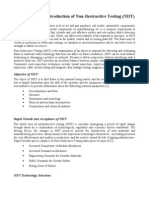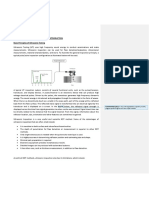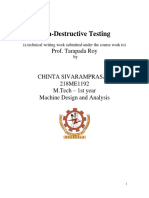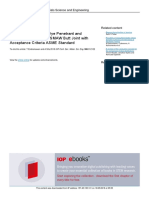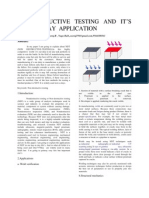Dimensional Measurements, Material Characterization, and More
Uploaded by
ozlem3472265Dimensional Measurements, Material Characterization, and More
Uploaded by
ozlem3472265wide group of analysis techniques used in science and industry to evaluate the properties of a material, component or system without
causing damage. Common NDT methods include ultrasonic, magnetic-particle, liquid penetrant, radiographic, remote visual inspection (RVI), eddy-current testing,[1] and low coherence interferometry.[3][4]
Ultrasonic
Ultrasonic Testing (UT) uses high frequency sound energy to conduct examinations and make measurements. Ultrasonic inspection can be used for flaw detection/evaluation, dimensional measurements, material characterization, and more. A typical UT inspection system consists of several functional units, such as the pulser/receiver, transducer, and display devices. A pulser/receiver is an electronic device that can produce high voltage electrical pulses. Driven by the pulser, the transducer generates high frequency ultrasonic energy. The sound energy is introduced and propagates through the materials in the form of waves. When there is a discontinuity (such as a crack) in the wave path, part of the energy will be reflected back from the flaw surface. The reflected wave signal is transformed into an electrical signal by the transducer and is displayed on a screen. Signal travel time can be directly related to the distance that the signal traveled. From the signal, information about the reflector location, size, orientation and other features can sometimes be gained.
Ultrasonic Inspection is a very useful and versatile NDT method. Some of the advantages of ultrasonic inspection that are often cited include:
It is sensitive to both surface and subsurface discontinuities. The depth of penetration for flaw detection or measurement is superior to other NDT methods. Only single-sided access is needed when the pulse-echo technique is used. It is highly accurate in determining reflector position and estimating size and shape. Minimal part preparation is required. Electronic equipment provides instantaneous results. Detailed images can be produced with automated systems. It has other uses, such as thickness measurement, in addition to flaw detection.
As with all NDT methods, ultrasonic inspection also has its limitations, which include:
Surface must be accessible to transmit ultrasound.
Skill and training is more extensive than with some other methods. It normally requires a coupling medium to promote the transfer of sound energy into the test specimen. Materials that are rough, irregular in shape, very small, exceptionally thin or not homogeneous are difficult to inspect. Cast iron and other coarse grained materials are difficult to inspect due to low sound transmission and high signal noise. Linear defects oriented parallel to the sound beam may go undetected. Reference standards are required for both equipment calibration and the characterization of flaws.
Weld verification
Weld verification
1. Section of material with a surface-breaking crack that is not visible to the naked eye. 2. Penetrant is applied to the surface. 3. Excess penetrant is removed. 4. Developer is applied, rendering the crack visible.
In manufacturing, welds are commonly used to join two or more metal parts. Because these connections may encounter loads and fatigue during product lifetime, there is a chance that they may fail if not created to proper specification. For example, the base metal must reach a certain temperature during the welding process, must cool at a specific rate, and must be welded with compatible materials or the joint may not be strong enough to hold the parts together, or cracks may form in the weld causing it to fail. The typical welding defects (lack of fusion of the weld to the base metal, cracks or porosity inside the weld, and variations in weld density) could cause a structure to break or a pipeline to rupture. Welds may be tested using NDT techniques such as industrial radiography or industrial CT scanning using X-rays or gamma rays,ultrasonic testing, liquid penetrant testing magnetic particle inspection or via eddy current. In a proper weld, these tests would indicate a lack of cracks in the radiograph, show clear passage of sound through the weld and back, or indicate a
clear surface without penetrant captured in cracks. Welding techniques may also be actively monitored with acoustic emission techniques before production to design the best set of parameters to use to properly join two materials.[5] In the case of high stress or safety critical welds, weld monitoring will be employed to confirm the specified welding parameters (arc current,arc voltage, travel speed, heat input etc) are being adhered to those stated in the welding procedure. This verifies the weld as correct to procedure prior to nondestructive evaluation and metalurgy tests.
Ultrasonic Inspection (UT)
Fig. 5 - Ultrasonic inspection detects discontinvities both on and below the weld surface. Compact, portable equipment makes it easy to use in the field.
Ultrasonic Inspection is a method of detecting discontinuities by directing a high-frequency sound beam through the base plate and weld on a predictable path. When the sound beam's path strikes an interruption in the material continuity, some of the sound is reflected back. The sound is collected by the instrument, amplified and displayed as a vertical trace on a video screen Both surface and subsurface defects in metals can be detected, located and measured by ultrasonic inspection, including flaws too small to be detected by other methods. The ultrasonic unit contains a crystal of quartz or other piezoelectric material encapsulated in a transducer or probe. When a voltage is applied, the crystal vibrates rapidly. As an ultrasonic transducer is held against the metal to be inspected, it imparts mechanical vibrations of the same frequency as the crystal through a couplet material into the base metal and weld. These vibrational waves are propagated through the material until they reach a discontinuity or change in density. At these points, some of the vibrational energy is reflected back. As the current that causes the vibration is shut off and on at 60-1000 times per second, the quartz crystal intermittently acts as a receiver to pick up the reflected vibrations.These cause pressure on the crystal and generate an electrical current. Fed to a video screen, this current produces vertical deflections on the horizontal base line. The resulting pattern on the face of the tube represents the reflected signal and the discontinuity. Compact portable ultrasonic
equipment is available for field inspection and is commonly used on bridge and structural work. Ultrasonic testing is less suitable than other NDE methods for determining porosity in welds, because round gas pores respond to ultrasonic tests as a series of single-point reflectors. This results in low-amplitude responses that are easiIy confused with "base line noise" inherent with testing parameters. However, it is the preferred test method for detecting plainertype discontinuities and lamination.
You might also like
- PCN Ultrasonic Testing Material Level 2 Material100% (5)PCN Ultrasonic Testing Material Level 2 Material131 pages
- Radiographic and Ultrasonic Testing of WeldsNo ratings yetRadiographic and Ultrasonic Testing of Welds3 pages
- Portrait University Research Poster in Blue Pink Playful and Illustrative StyleNo ratings yetPortrait University Research Poster in Blue Pink Playful and Illustrative Style1 page
- Introduction of Non-Destructive Testing (NDT)No ratings yetIntroduction of Non-Destructive Testing (NDT)7 pages
- History: Non-Destructive Testing UltrasonicNo ratings yetHistory: Non-Destructive Testing Ultrasonic32 pages
- UL TRA Sonic TES Ting: Afnor Associated StandardsNo ratings yetUL TRA Sonic TES Ting: Afnor Associated Standards2 pages
- Radiographic and Ultrasonic Testing of WeldsNo ratings yetRadiographic and Ultrasonic Testing of Welds1 page
- Fundamentals of Ultrasonic Inspection : Revised by Leonard J. Bond, Iowa State UniversityNo ratings yetFundamentals of Ultrasonic Inspection : Revised by Leonard J. Bond, Iowa State University14 pages
- Module 4 Ultrasonictesting and AE TestingNo ratings yetModule 4 Ultrasonictesting and AE Testing10 pages
- Non-Destructive Testing: Prof. Tarapada RoyNo ratings yetNon-Destructive Testing: Prof. Tarapada Roy12 pages
- Endramawan 2018 IOP Conf. Ser. Mater. Sci. Eng. 306 012122No ratings yetEndramawan 2018 IOP Conf. Ser. Mater. Sci. Eng. 306 01212210 pages
- Phased Array Ut Procedure For Welds: Industrial Engineering Services100% (2)Phased Array Ut Procedure For Welds: Industrial Engineering Services14 pages
- Use of Ultrasonic Testing in The Structural Steel IndustryNo ratings yetUse of Ultrasonic Testing in The Structural Steel Industry5 pages
- Capabilities and Limitations of Radiography and Phased Array Ultrasonic Test in The Detection of Subtle Welding DefectsNo ratings yetCapabilities and Limitations of Radiography and Phased Array Ultrasonic Test in The Detection of Subtle Welding Defects8 pages
- Day-7 Testing and Inspection of Weldments-ME6007-3!3!2016No ratings yetDay-7 Testing and Inspection of Weldments-ME6007-3!3!201654 pages
- Ultrasonic Testing Ndt4 Rev 0: TWI LTD, Training & Examination ServicesNo ratings yetUltrasonic Testing Ndt4 Rev 0: TWI LTD, Training & Examination Services114 pages
- Ultrasound Analysis for Condition Monitoring: Applications of Ultrasound Detection for Various Industrial EquipmentFrom EverandUltrasound Analysis for Condition Monitoring: Applications of Ultrasound Detection for Various Industrial Equipment4.5/5 (3)
- New Sensors and Processing ChainFrom EverandNew Sensors and Processing ChainJean-Hugh ThomasNo ratings yet
- Guidelines for the Determination of Standardized Semiconductor Radiation Hardness ParametersFrom EverandGuidelines for the Determination of Standardized Semiconductor Radiation Hardness ParametersNo ratings yet
- Chbe 251 - Transport Phenomena I Tutorial IiiNo ratings yetChbe 251 - Transport Phenomena I Tutorial Iii17 pages
- Haque Muhammad MASc Thesis - AP - May 18 2010 - FinalNo ratings yetHaque Muhammad MASc Thesis - AP - May 18 2010 - Final106 pages
- Tooth Coloured Restorative Materials Final100% (2)Tooth Coloured Restorative Materials Final166 pages
- AA200A Applied Aerodynamics: Chapter 1 - Introduction To Fluid FlowNo ratings yetAA200A Applied Aerodynamics: Chapter 1 - Introduction To Fluid Flow42 pages
- 4.1 Newton's Law of Restitution For Direct ImpactNo ratings yet4.1 Newton's Law of Restitution For Direct Impact5 pages
- Analysis of The Magnetic Field, Force, and Torque ForNo ratings yetAnalysis of The Magnetic Field, Force, and Torque For11 pages
- Forced Vibration Applications Vibration Isolation - FTR, DTRNo ratings yetForced Vibration Applications Vibration Isolation - FTR, DTR4 pages
- Influence of Surface Effects On The Electrostatic Separation of Zircon and RutileNo ratings yetInfluence of Surface Effects On The Electrostatic Separation of Zircon and Rutile6 pages
- Portrait University Research Poster in Blue Pink Playful and Illustrative StylePortrait University Research Poster in Blue Pink Playful and Illustrative Style
- Fundamentals of Ultrasonic Inspection : Revised by Leonard J. Bond, Iowa State UniversityFundamentals of Ultrasonic Inspection : Revised by Leonard J. Bond, Iowa State University
- Endramawan 2018 IOP Conf. Ser. Mater. Sci. Eng. 306 012122Endramawan 2018 IOP Conf. Ser. Mater. Sci. Eng. 306 012122
- Phased Array Ut Procedure For Welds: Industrial Engineering ServicesPhased Array Ut Procedure For Welds: Industrial Engineering Services
- Use of Ultrasonic Testing in The Structural Steel IndustryUse of Ultrasonic Testing in The Structural Steel Industry
- Capabilities and Limitations of Radiography and Phased Array Ultrasonic Test in The Detection of Subtle Welding DefectsCapabilities and Limitations of Radiography and Phased Array Ultrasonic Test in The Detection of Subtle Welding Defects
- Day-7 Testing and Inspection of Weldments-ME6007-3!3!2016Day-7 Testing and Inspection of Weldments-ME6007-3!3!2016
- Ultrasonic Testing Ndt4 Rev 0: TWI LTD, Training & Examination ServicesUltrasonic Testing Ndt4 Rev 0: TWI LTD, Training & Examination Services
- Ultrasound Analysis for Condition Monitoring: Applications of Ultrasound Detection for Various Industrial EquipmentFrom EverandUltrasound Analysis for Condition Monitoring: Applications of Ultrasound Detection for Various Industrial Equipment
- Guidelines for the Determination of Standardized Semiconductor Radiation Hardness ParametersFrom EverandGuidelines for the Determination of Standardized Semiconductor Radiation Hardness Parameters
- Rebound Hammer Test and Non Destructive Testing of ConcreteFrom EverandRebound Hammer Test and Non Destructive Testing of Concrete
- Haque Muhammad MASc Thesis - AP - May 18 2010 - FinalHaque Muhammad MASc Thesis - AP - May 18 2010 - Final
- AA200A Applied Aerodynamics: Chapter 1 - Introduction To Fluid FlowAA200A Applied Aerodynamics: Chapter 1 - Introduction To Fluid Flow
- Analysis of The Magnetic Field, Force, and Torque ForAnalysis of The Magnetic Field, Force, and Torque For
- Forced Vibration Applications Vibration Isolation - FTR, DTRForced Vibration Applications Vibration Isolation - FTR, DTR
- Influence of Surface Effects On The Electrostatic Separation of Zircon and RutileInfluence of Surface Effects On The Electrostatic Separation of Zircon and Rutile








